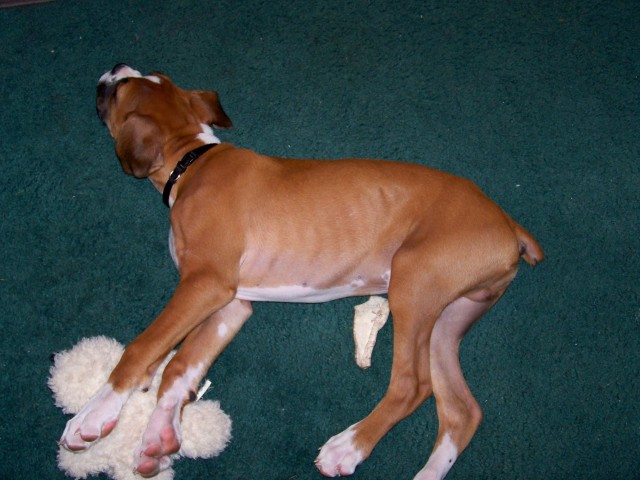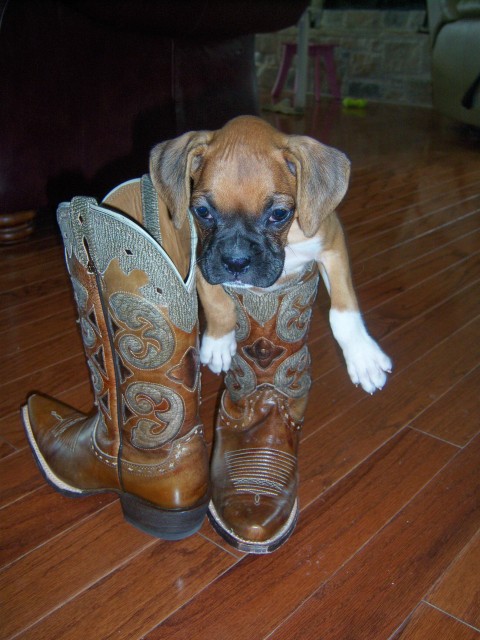QuestionI have two beautiful adolescent Boxers. We were not strict enough when teaching them to walk and now experience a lot of pulling on the leash. We have gone from chokers to pinschers (neither of which we like) and are now using the Gentle Leader. Maggie is quite small and the halti bothers her tremendously. She spends 99 percent of the walk rubbing her face on the ground. Do they make a halti for boxers/pug-faced dogs? Do you have any other suggestions?
AnswerHi Tiffany!
To answer your question very quickly, no, there are no special halti's for short faced breeds.
Now for the long answer. :)
Chokers and prong collars won't teach your dog to walk nicely. Nor will a halti. All of these are training tools that only work when the dog is wearing them. I'm assuming here that your goal is for your dogs to walk nicely when wearing a normal collar or harness. If that's your desire, start with that and stick with it.
I walk my dogs on a harness because I feel I have more control if they should see a rabbit or squirrel and decide today is a good day to play. What I am going to explain to you will work with a normal collar (cotton, nylon, leather) or a regular harness (not a no-pull harness).
There are 2 methods. Choose one and stick with it.
1. Be a Tree: take your dog out and decide how long you want to be out for. A good goal is 20-30 minutes. That's normally how long your patience will hold out. ;)
When your dog starts pulling, stop. Don't make eye contact, don't speak. Just stop and stand still. As soon as the dog stops pulling, tell him 'easy' and start walking. When he pulls, you stop again. Continue this for your allotted amount of time and then go in the house. (Be sure to include the driveway in your training). Try to end on a positive note...for instance, don't let the dog pull you into the house. If you need to stop at the door and wait for him to be calm, wait. Walk in when he's at his 'easy' point.
2. Turn and walk: most dogs are pulling because they want to get somewhere. Decide how far you're going to go. A good goal, if you live in the city, is the longer end of one block. Keep a normal pace (for you, NOT for the dog). When the dog starts to pull, give a quick correction on the collar (not quite a jerk but enough to get the dogs attention) and turn and go a different direction (be sure to keep your pace). When the dog is not pulling, be sure to give the 'easy' command and praise. As soon as he starts pulling, correct, turn and go. So on and so on. This one is also very good on a long line in a field or park. You can use a 15 or 20 foot long line (available in the leash aisle)...letting the dog get to the end of the lead and you go the other way (w/out the correction).
If you're using a retractable lead, don't. Get a 6ft cotton or leather leash. (Nylon will be hard on your hand).
Neither of these methods will work in a week's time. You'll need patience and perseverance but it will be WELL worth it in the end. What you do, using either type of training, is teach your dog to walk properly because he's supposed to...with the other methods it's because he has to. Make sense?
If you need more help, please let me know. Whichever you choose, you should be sure to do it daily and the dog's should not be walked when you aren't in the mood for the lesson. Teaching one day and then letting them goof off on lead the next won't work. :)

 Puppys weight.
Question
Champ at 12 weeks.
Hello,
I wanted some infor
Puppys weight.
Question
Champ at 12 weeks.
Hello,
I wanted some infor
 Nursing
QuestionTeat Image #1
QUESTION: Hi, I have a 2 y
Nursing
QuestionTeat Image #1
QUESTION: Hi, I have a 2 y
 boxer puppy (female)
QuestionQUESTION: 1. is there a way to find out if our
boxer puppy (female)
QuestionQUESTION: 1. is there a way to find out if our
 Boxer puppy size
Question
Cougar 7 weeks
Hi,
We have a 15 week ol
Boxer puppy size
Question
Cougar 7 weeks
Hi,
We have a 15 week ol
 9 week old female
Question
Bentlee
Hi my name is Kelsi... My little Bentl
9 week old female
Question
Bentlee
Hi my name is Kelsi... My little Bentl